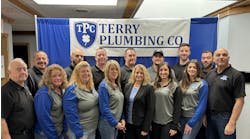Latest from Plumbing Contractor
Sponsored
Solar is mainstream — and that means more rules
Solar has been booming in the U.S. over the past four years, a bright spot in a mediocre economy and evidence that consumers are paying attention to trending price-points in renewable energy technologies.
According to CleanTechnica.com, solar energy capacity in the U.S. grew 418% from 2010-2014, and upward trends are forecast through 2016. Much of the solar growth is due to federal and state incentive programs, but the industry is quick to point out that lower panel prices and higher efficiency will continue to make solar a good investment even after incentives expire in a few years.
The rapid solar growth has helped the construction job market also. The Solar Foundation’s Solar Job Census 2013 reported there were 143,000 solar workers in the U.S. in 2013, but that number could include salespeople as well as technical workers and installers. Despite the large increase in solar workers, the number of certified solar installers is still relatively small.
According to the North American Board of Certified Energy Practitioners (NABCEP), there is a total of 3,080 certified installers in various aspects of solar. A NABCEP category for Entry Level Solar Installer, however, and has ballooned over the last few years to 25,450. Still, the solar industry has some serious training issues to resolve.
Comparatively, traditional industries such as the plumbing and electrical trades have a much higher percentage of trained workers. Whereas solar installers learn mostly on-the-job and in intensive one or two week courses, construction trades workers generally have graduated from a four or five year comprehensive apprenticeship program. For obvious reasons, plumbers and electricians have skills that are highly sought after in the solar industry.
Despite the recent growth of solar in the U.S., there remains plenty of room for solar expansion. Germany currently produces fifteen times more solar energy than the U.S. On a recent very sunny day in Germany, solar energy output was 50% of the total electrical demand for the entire country! Australia is coming along as well, with a target of 20% of its electrical generation from Renewable sources by 2020. (Source http://ret.cleanenergyregulator.gov.au/)
Codes, quality and safety
While solar photovoltaics (PV) is grabbing the lion’s share of the market these days, the solar heating and cooling industry is likewise experiencing excellent growth. As the market has expanded over the last ten years, more interest has been given to solar product certification, performance rating of solar products and systems, and installation codes.
The International Association of Plumbing and Mechanical Officials (IAPMO) began publishing the Uniform Solar Energy Code (USEC) in 1976. The USEC is a comprehensive compendium of best practices for the construction of solar heating systems.
Every three years this code is updated to reflect the state of the art; work on the 2015 edition is already well underway. However, next year’s edition has a new twist – for the first time it will include sections on hydronics, and most notably radiant panel heating systems.
Along with IAPMO’s Uniform Plumbing and Uniform Mechanical Codes, the 2015 Uniform Solar Energy and Hydronics Code (USEHC) is developed and maintained as an American National Standard, meaning that unlike other building codes it is developed under the American National Standard Institute’s (ANSI) consensus standard development process. This means that participation in the code development process is open to all, and that the final document reflects the knowledge and expertise of a wide variety of contributors. Look for the 2015 USEHC to be published in late summer 2015.
In keeping with the recent solar heating and cooling growth and the need for more open, transparent standards, IAPMO has also been busy in the product standards development area. In November 2013, IAPMO announced the acceptance by ANSI of IAPMO S1001.1 Design and Installation of Solar Water Heating Systems.
This comprehensive, consensus American National Standard covers the fundamentals of packaged solar water heating system designs for residential and small commercial applications. Also, work is well underway on IAPMO S1001.2 Performance Rating of Solar Water Heating Systems, which standardizes a procedure for calculating the energy production of solar water heating systems at over 1,000 locations around the US. This new standard is expected to be published in late 2014.
On another front, in 2011 the U.S. Environmental Protection Agency held a number of meetings with the objective of developing a heat metering standard for the U.S. Accurately metering the heat produced by solar and other renewable heat energy producing systems is an important precursor to successfully establishing a market for the valuation and eventual trading of Renewable Energy Credits, or Renewable Energy Certificates, also known as “RECs.”
A REC is a verified, tradable financial instrument that represents proof that a certain amount of renewable energy has been generated. A market for renewable electricity RECS is fairly well established in a number of U.S. jurisdictions, however a similar market for renewable heat-based RECs has been longer in materializing, in part due to the complexity of measuring heat flow, as well as the lack of a U.S. standard for doing so. In early 2012 EPA announced that accredited standards developers ASTM International and IAPMO would jointly develop this new standard, which will be based on an existing European standard, adapted to U.S. conventions, standards and practices. Look for this new standard in 2015.
Internationally, IAPMO was pleased to announce in 2012 that, along with IAPMO’s Uniform Plumbing and Unified Mechanical Codes, the Uniform Solar Energy Code was developed and released, to be utilized as the base document for the industry.
IAPMO is actively working in other regions of the world to assist countries in developing their own codes to help ensure their citizens’ health and safety.
In regard to global certification, and in an effort to develop a global solar product certification program, the Global Solar Certification Network (GSCN) is being developed under the auspices of the International Energy Agency’s Solar Heating and Cooling Program. Its initial focus will be on an internationally accepted solar collector certification protocol known as ISO 9806-2013, developed under the auspices of the International Organization for Standardization.
The near-term goal of the GSCN is to gain acceptance of the ISO 9806-2013 collector testing protocol by as many nations as possible. This international standard was formally adopted by IAPMO in early 2014, and is an active participant in the effort to finalize the GSCN working rules and regulations. The vision of the GSCN is to establish one solar certification, to be is accepted by all countries, thereby reducing costs for manufacturers and consumers while standardizing product testing and quality control. The goal is to help ensure that durable, high performance solar heating systems will function reliably for consumers worldwide.
We have only just scratched the surface when it comes to opportunity and technology throughout the Solar Industry, and as the global market has seen over the past few years – this is just the tip of the iceberg behind the genuine concept of harnessing the true energy of the sun.
Please note that Les Nelson, VP of Solar Heating & Cooling Programs, IAPMO contributed to this report.
Megan Lehtonen is the VP of International Business Development for The IAPMO Group, currently overseeing the India and Australia offices. IAPMO continues to lead the effort in water and energy conservation practices on a global level, while protecting health and safety through effective plumbing codes and standards. Prior to joining IAPMO, Megan served as president of management company Onni Inc. for 10 years, including the formation of GreenPlumbers USA in 2007. She was presented with an outstanding achievement award by the Environmental Protection Agency in March 2009 for GreenPlumbers’ contribution to environmental education.

